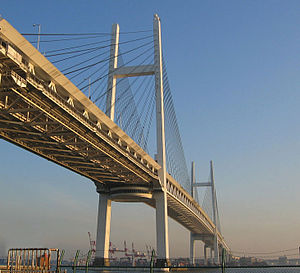Yokohama Bay Bridge
Coordinates: 35 ° 27 ′ 16 ″ N , 139 ° 40 ′ 26 ″ E
| Yokohama Bay Bridge 横 浜 ベ イ ブ リ ッ ジ |
||
|---|---|---|
| Convicted | Tokyo City Highway , Wangan Line | |
| place | Yokohama | |
| construction | Cable-stayed bridge | |
| overall length | 860 m | |
| width | 40.2 m | |
| Longest span | 460 m | |
| Clear height | 55 m | |
| start of building | 1980 | |
| opening | September 27, 1989 | |
| toll | toll | |
| location | ||
|
|
||
| Yokohama Bay Bridge with Sky Lounge below the bridge girder in front of the first pylon | ||
The Yokohama Bay Bridge ( Japanese 横 浜 ベ イ ブ リ ッ ジ , Yokohama bei Burijji ) is a double-storey road bridge on the Tokyo Metropolitan Expressway (Metropolitan Expressway Bayshore Route), which serves , among other things, Haneda Airport , 17 km to the northeast .
description
The entire bridge structure is approximately 2 km long, including the ramp bridges that lead to a multiple intersecting roundabout ( Daikoku Junction ) in the northeast .
The city motorway runs on the upper deck of the bridge with two directional lanes of 3 lanes each, a narrow hard shoulder and a narrow sidewalk for the maintenance workers. In the lower deck there is one lane each for the connection classified here as national road 357 for local traffic, which can be expanded to four or six lanes if necessary. Light motorbikes, bicycles and pedestrians were not allowed to cross the bridge.
Immediately next to the northern ramp bridge is the Sky Tower , the upper floors of which are connected to the bridge or the Skywalk , a covered pedestrian walkway that was attached to the outside of the lower bridge girder. It leads to the Sky Lounge below the bridge girder on the first pylon. On the other side of the bridge, the same footbridge leads back to the Sky Tower .
The actual cable-stayed bridge has a length of 860 m between the transition structures to the ramp bridges, whereby it must be taken into account that these transition structures are supported on pillars that are about 45 m away from one bank and 60 m from the other. The span between the pylons standing in the water is 460 m, the side openings have spans of 200 m. The pylons are 175 m high H-shaped steel structures. The 40.2 m wide bridge deck consists of a 13.75 m high steel lattice girder ; the subsequent ramp bridges also have the same construction. The stay cables arranged at the outer edge of the bridge deck are double-sided, closely spaced and equipped with vibration dampers. The bridge has a clearance height of 55 m. This height was chosen at the time to allow Queen Elizabeth 2 to pass, but is no longer sufficient for many of today's, much taller cruise ships, which causes problems for the port administration.
Construction of the bridge began in 1980 and its opening took place on September 27, 1989. The two lanes on the lower deck were installed in 2004.
Web links
Individual evidence
- ↑ Stroll Along Yokohama Bay Bridge Sky Walk ( Memento from April 16, 2013 in the Internet Archive ) on Yokohama Visitors' Guide
- ↑ Yokohama Bay Bridge on the Shutoku - Metropolitan Expressway Company Ltd. website. (Japanese)
- ↑ Yokohama Bay Bridge too low for modern ships Article from May 13, 2013 on asiaone


